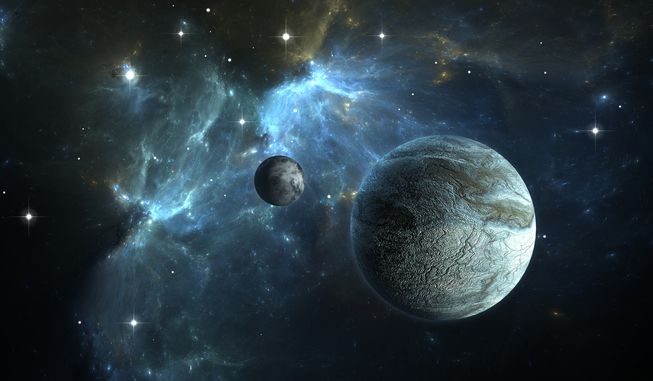为什么在其他行星上寻找生命要依靠氢气
为什么在其他行星上寻找生命要依靠氢气
Right now, there are more than 4,000 known exoplanets and plenty of other possible planets that need to be assessed. While we're not going to put human boots on the ground on all these worlds to search for alien life, there are a variety of remote methods to look for current or ancient life.
目前,已知的系外行星有4000多颗,还有很多其他可能的行星需要评估。虽然我们不会为了寻找外星生命而把人类的足迹踏遍所有的星球,但我们可以通过各种各样的远程方法来寻找现代或古代的生命。

We could find life on a planet that has a far different combination of atmospheric gases. (Photo: Jurik Peter/Shutterstock)
Scientists aren't on the lookout for little green men. What astrobiologists and planetary scientists are searching for is akin to the life that developed and flourished for the billions of years before humans even evolved. They're looking for evidence of basic life, like single- or multi-celled organisms on the order of bacteria, viruses, or algae.
科学家们并不是在寻找小绿人。天体生物学家和行星科学家正在寻找的,与在人类进化前数十亿年就已经发展和繁荣起来的生命类似。他们正在寻找基本生命的证据,比如细菌、病毒或藻类的单细胞或多细胞生物。
That other life could be found on planets that have a very different atmosphere than our own. After all, even here, life developed under conditions than would seem strange to us. The younger Earth had less-intense sunlight and a lot more methane in the atmosphere compared to our current oxygen-rich air. Understanding that may be key to finding life elsewhere.
另一种生命可能存在于与我们的大气层截然不同的行星上。毕竟,即使在这里,生命也是在我们看来陌生的条件下发展起来的。与我们现在富氧的空气相比,年轻的地球没有那么强烈的阳光,大气中有更多的甲烷。理解这一点可能是在其他地方发现生命的关键。
"[Our research] is not looking for another Earth per se," Timothy Lyons, a professor in the Department of Earth and Planetary Sciences at the University of California, Riverside told Astrobiology Magazine. Lyons heads up NASA's Alternative Earths team, which gathers information on what we can learn from the early days on this planet to better understand what might support life elsewhere.
加州大学河滨分校地球与行星科学系教授蒂莫西·莱昂斯在接受《天体生物学》杂志采访时表示:“(我们的研究)并不是寻找另一个地球。”莱昂斯领导着美国国家航空航天局的“替代地球”小组,该小组收集有关我们能从地球早期了解到的信息,以便更好地理解什么可能支持其他地方的生命。
"It's more about looking for the different pieces of what it is to be a planet that can sustain life. Once you know what those processes do on a planet like Earth, you can assemble them into countless other planetary scenarios that may or may not be able to do the same thing."
“这更多的是寻找一个能够维持生命的行星的不同部分。一旦你知道这些过程在像地球这样的行星上发生了什么,你就可以把它们组合成无数的其他行星情景,这些情景可能会发生,也可能不会发生。”
Why hydrogen-based life is possible
为什么氢基生命是可能的
Looking around our galaxy, most accessible rocky planets are hydrogen-based, but could life develop and survive there? Until we find life on one of these planets, we can't know the answer for sure. But we do know it's possible, according to new research via the Massachusetts Institute of Technology.
环顾我们的银河系,最容易找到的岩石行星都是以氢为基础的,但生命能在那里发展和生存吗?直到我们在这些行星中找到生命,我们才能确切地知道答案。但根据麻省理工学院的最新研究,我们知道这是可能的。
Perhaps surprisingly, the scientists found that some tough earth-based organisms could survive in a hydrogen-based atmosphere: E. coli (the same as the kind that lives in our gut) and yeast "can survive and grow in a 100% H2 atmosphere," according to the paper in Nature Astronomy.
也许令人惊讶的是,科学家们发现一些坚硬的地球生物可以在氢的环境中生存:大肠杆菌(与生活在我们肠道中的细菌相同)和酵母“可以在100% H2的环境中生存和生长”,根据《自然天文学》杂志上的文章。
They also found an "astonishing diversity of dozens of different gases produced by E. coli, including many already proposed as potential biosignature gases (for example, nitrous oxide, ammonia, methanethiol, dimethylsulfide, carbonyl sulfide and isoprene)," the paper's authors write.
他们还发现了“大肠杆菌产生的几十种不同气体的惊人多样性,包括许多已经被提出的潜在的生物特征气体(例如,一氧化二氮、氨、甲硫醇、二甲基硫化物、羰基硫化物和异戊二烯),”论文的作者写道。
How atmospheres can reveal possible life
大气如何揭示可能存在的生命
Knowing which gases could be indicators of hydrogen-based life, or biosignatures, is the key.
关键是要知道哪些气体可能是氢基生命或生物特征的指示物。
Scientists can do this from Earth by looking at the light that passes through that atmosphere when the planet passes in front of its star. How the light is broken down as it passes through the atmosphere can give details about what's in that atmosphere. Of course, this takes a very powerful telescope, but it's possible.
科学家们可以从地球上通过观察当行星从其恒星前面经过时穿过大气层的光来做到这一点。光在穿过大气层时是如何被分解的可以提供关于大气层中物质的细节。当然,这需要非常强大的望远镜,但这是可能的。
So if researchers find a hydrogen-based planet, and find the biosignature gases, that could indicate that life exists there. Of course, it's possible that life that evolved on an exoplanet might not give off those specific gases, but it would be a useful clue about where to search if they did.
因此,如果研究人员发现了一颗以氢为基础的行星,并发现了具有生物特征的气体,那就可能表明那里存在生命。当然,在系外行星上进化出来的生命可能不会释放出那些特定的气体,但如果它们释放了,这将是一条有用的线索,告诉我们去哪里寻找。
All of this information isn't a guarantee of where to go and what we might find when we get there, but with over 4,000 planets to consider, it's useful to have a way to narrow down where to start the search for alien life.
所有这些信息并不能保证我们去哪里,也不能保证当我们到达那里时会发现什么,但是有超过4000颗行星需要考虑,有一种方法可以缩小寻找外星生命的范围,这是很有用的。
- 频道推荐
- |
- 全站推荐
- 推荐下载
- 网站推荐


















